
Budget Plan - Chapter 2

|
|
|
Economic Development and Prospects1 |
| - Franšais - Table of Contents - Next - | |
In 1999, the Canadian economy rebounded strongly from the slow growth in mid-1998 caused by the financial and economic crisis that began in Asia in 1997 and then spread to Russia and Latin America. Since late 1998, the Canadian economy has expanded at a healthy pace, exceeding the expectations of all forecasters surveyed. Real gross domestic product (GDP) growth in 1999 is estimated to have averaged 3.8 per cent.
This resilience reflects the Government’s commitment to sound economic and financial policies – low inflation and balanced budgets. Strong fundamentals supported a rapidly strengthening domestic economy, which in turn helped to sustain Canada’s economic performance during the recent period of economic and financial turbulence.
As well, solid fundamentals have enabled Canada to take advantage of improving international economic conditions. Continued strong growth in the United States, accelerating economic growth in Europe and economic recovery in Asia have contributed to the rebound in the Canadian economy.
As a result, Canadian economic growth is forecast to remain healthy in 2000 and 2001, although at a slightly slower pace than in 1999, reflecting an expected slowing in the U.S. economy. On average, private sector forecasters now predict that real GDP growth will be 3.5 per cent in 2000 and 2.9 per cent in 2001.
There is growing evidence of a widespread and increasingly balanced recovery in global growth, coming considerably earlier than expected. The OECD estimates world economic growth to have risen sharply to 3.0 per cent in 1999, from 2.2 per cent in 1998. Among major economies, the U.S. has continued to post strong growth in output and productivity while still showing few signs of wage and price pressures, even though its unemployment rate remains at a 30-year low.
While the U.S. economy has continued to act as the locomotive of the global economy, hopeful signs are emerging that conditions are strengthening in other major economies, particularly in Europe. A number of Asian economies have also embarked on strong recoveries, reflecting the earlier lowering of interest rates globally, as well as their implementation of essential financial and economic reforms. In reaction to these developments, as well as some supply factors, energy prices have risen significantly and other commodity prices have begun to pick up.
With global economic conditions improving earlier and more than expected, major central banks have started to raise interest rates from the low levels required when financial instability posed a significant risk of a global economic downturn. But despite the recent increases, interest rates remain supportive of global growth.
Global financial market turmoil led to a spike in Canadian interest rates in August 1998. Canada’s low inflation and strong fiscal performance, however, meant that the increase in interest rates was quickly unwound as financial market confidence was restored. As a result, Canada experienced only a modest slowdown in growth in 1998 despite the sharp deterioration in world economic conditions. Moreover, Canada’s strong fundamentals meant that the economy was well positioned to take advantage of the improvement in international economic conditions that began in late 1998.
The economy consistently outpaced private sector forecasters’ expectations by a wide margin through 1999. Growth strengthened in 1999 and reached 4.7 per cent in the third quarter. Growth is now estimated by private sector forecasters to have averaged 3.8 per cent in 1999, almost double the average forecast at the time of the 1999 budget. The rebound in growth was fuelled by a combination of a stronger international economy, most notably continuing strong growth in the U.S., stronger commodity prices and improving domestic demand. The surge in domestic demand (Chart 2.1) reflects Canada’s low interest rates, improved confidence and strong employment growth.
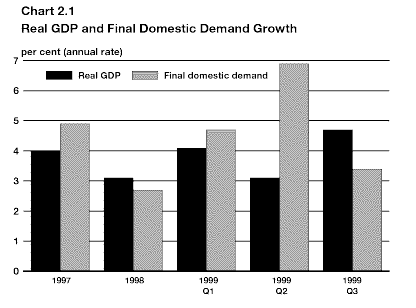
Ongoing solid economic growth has contributed to strong job creation in Canada (Chart 2.2), with almost 1.3 million jobs created from December 1996 to January 2000. The pace of job creation in Canada over this period has been almost double that in the U.S. Of this total, some 427,200 jobs were added in 1999, all of them full-time, with solid gains in all regions of the country (Chart 2.3). Another 44,300 jobs were added in January. Youth employment has increased strongly: it is up almost 230,000 since the end of 1997 – an average annual growth rate of over 5 per cent.
The unemployment rate dropped more than one percentage point through 1999. By December, the sustained strength of job creation had brought the unemployment rate down to 6.8 per cent, its lowest level since April 1976 (Chart 2.4).
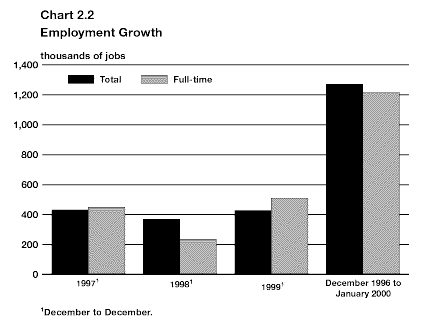
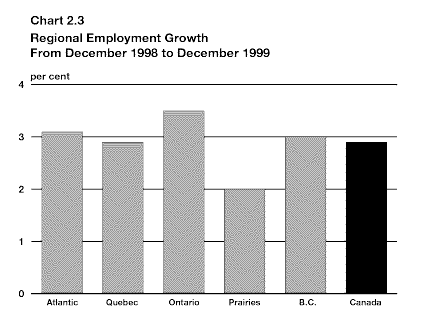
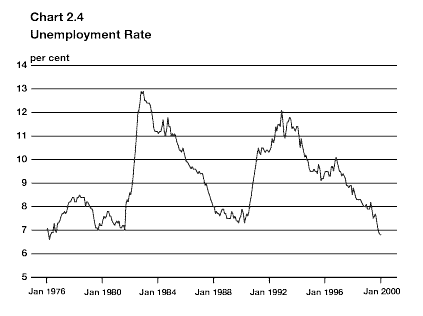
The sustained strong job-market performance has contributed to solid personal income growth. Indeed, the inflation-adjusted after-tax income of Canadians has increased steadily since 1996, rising almost 3 per cent and recovering more than half of the loss that occurred in the first half of the 1990s (Chart 2.5).
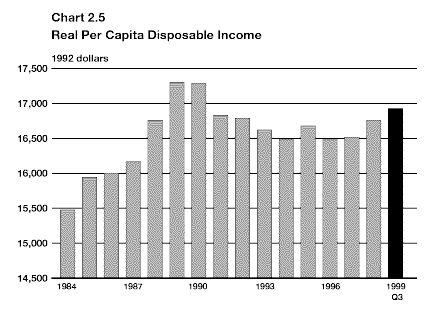
In turn, domestic demand has been buoyed by strong employment and income growth which, together with low interest rates, have boosted consumer and business confidence (Chart 2.6). Consumer confidence increased strongly in 1999, rebounding to near its 1997 peak. Business confidence has also bounced back sharply since the end of 1998 and is now almost equal to the record high reached in the second quarter of 1997.
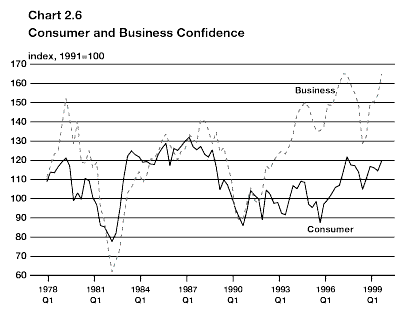
With substantial income growth generated by a healthy labour market, consumer spending rebounded strongly after stalling at the end of 1998, growing over 4 per cent in each of the first three quarters of 1999. Spending on consumer durables, such as automobiles, was particularly strong. Residential investment also surged in 1999, with growth in spending on new construction averaging 12.6 per cent over the first nine months, while home resales hit their highest level in two and a half years in the second quarter of 1999.
Business investment, which had slowed noticeably in 1998 in response to the Asian crisis, also contributed to the pickup in economic activity, particularly during the first half of the year. This resurgence reflected renewed confidence and improved profitability, as well as spending by Canadian firms to ensure Y2K computer compliance. In the third quarter, however, business investment slowed as machinery and equipment spending fell slightly, reflecting in part a tapering off of growth in spending on computers and office equipment.
Strong U.S. growth, combined with economic recovery in Asia, has contributed to a rebound in commodity prices back to the levels recorded before the onset of the Asian crisis (Chart 2.7). Energy prices in particular have bounced back sharply, boosted by low world inventories and stricter adherence to production quotas by the Organization of the Petroleum Exporting Countries. Non-energy commodity prices, such as the price for base metals, have also recovered, reflecting the improvement in world economic conditions. Some agricultural commodity prices, however, remain low.
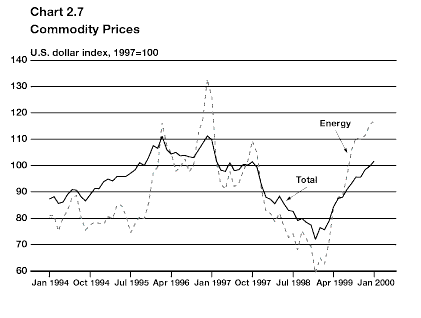
Higher commodity prices have boosted aggregate export prices relative to import prices – otherwise described as an improvement in the terms of trade. As well, the continued strength of the U.S. economy has made an important direct contribution to Canadian growth, leading to a strong improvement in the real trade balance. It surged in the third quarter due to broad-based strength in exports, particularly exports of automotive products and machinery and equipment to the U.S. (Chart 2.8).
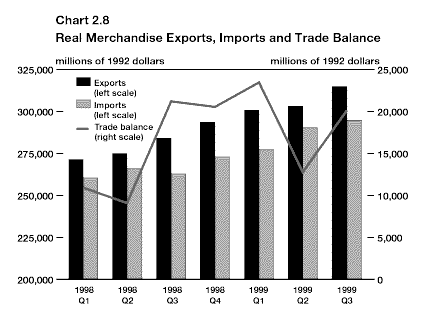
Canada’s improved international competitiveness vis-Ó-vis the U.S. also contributed to the improvement in the trade balance. Continued productivity growth, together with moderate wage gains consistent with Canada’s low inflation performance, has resulted in slower growth in unit labour costs in Canada than in the U.S. (Chart 2.9).
The improvement in the trade balance swung the current account into surplus in the third quarter of 1999 for the first time since 1996 (Chart 2.10). In 1997 and 1998, the current account deficit – which corresponds to an increase in Canada’s net foreign indebtedness – averaged about $15 billion or 1.7 per cent of GDP. But since the beginning of 1999, the current account has improved significantly and is expected to remain close to balance. Canada’s net foreign indebtedness fell from a peak of nearly 45 per cent of GDP in 1993 to 36 per cent in 1998, and is estimated to have fallen again last year, imposing a far smaller burden on Canadian living standards (Chart 2.11).
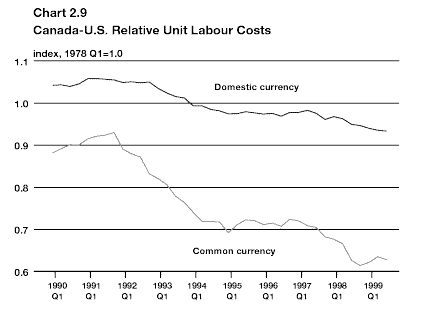
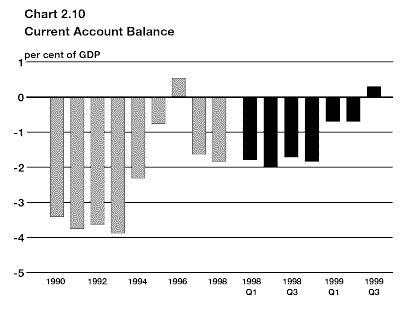
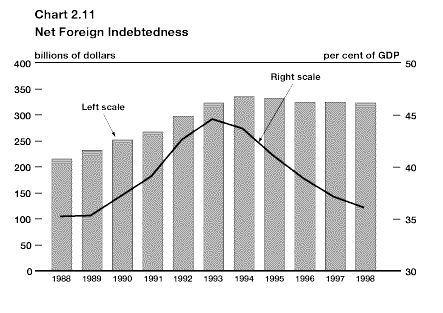
Consumer price inflation increased only modestly in 1999 and remains subdued. The rise was mainly due to the impact of earlier declines in the value of the Canadian dollar (which over time boosts import costs) and higher energy prices, reflecting the doubling of world oil prices over the past year. In December 1999, the year-over-year consumer price index (CPI) inflation rate was 2.6 per cent while the inflation rate (which excludes the impact of food and energy) was 1.6 per cent, just under the middle of the 1-to-3 per cent inflation control target band set jointly by the Government and the Bank of Canada (Chart 2.12).
Producer price growth, as measured by the GDP deflator, also increased in 1999, after having been negative (-0.6 per cent) in 1998. In the first three quarters of 1999, the GDP deflator was 1.2 per cent higher than its 1998 average level. The pickup was mainly due to higher prices for Canadian exports.
Sustained low inflation coupled with a solid fiscal performance brought Canadian interest rates down substantially in recent years from their mid-1990s levels. After rising sharply in response to the fallout from the Asian crisis, short-term interest rates fell again in early 1999, as the Bank of Canada cut the Bank Rate 25 basis points in March and again in May. Since then, stronger-than-expected global growth and fears of an emergence of inflationary pressures in the U.S. have put upward pressure on interest rates – the Bank Rate increased 25 basis points in November. Those pressures have intensified since December in light of further evidence that the U.S. economy was continuing to grow much faster than expected. As a result, both short- and long-term rates have moved up in the U.S. and Canada – the Bank Rate increased 25 basis points in early February. However, Canadian rates remain well below their recent peaks in 1995 (Chart 2.13) and are still below U.S. rates at all maturities.
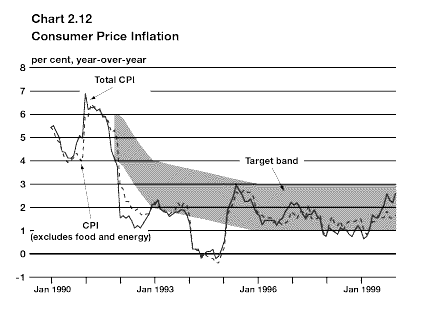
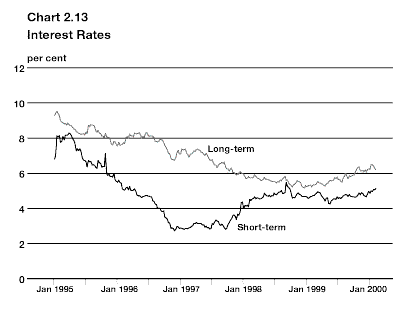
| Budget 2000 Publications | Budget 2000 Main Page |